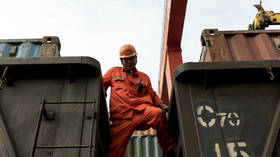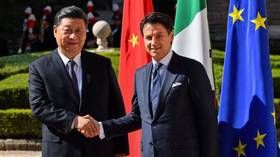
The Belt and Road Initiative is proclaimed to be an act of solidarity with developing nations. It is, but it is also so much more
By Timur Fomenko, a political analyst

An empoyee of China-Kazakhstan Logistic Base climbs a shipping train in Lianyungang, Jiangsu Province, China on September 17, 2021 © Raul Ariano / Jiangsu Information Office
“China’s overseas investment in metals and mining set to hit record” states an article in the Financial Times. The piece dives into an analysis about how China’s investments in the Belt and Road Initiative, a massive global infrastructure program, have become more “strategic.”
While the FT is notoriously negative about China and spares no opportunity to rush into narratives pertaining to ‘debt traps,’ claims of corruption, and how ‘dozens’ of countries are reviewing them (only citing US-pressured Italy as an example), it nonetheless makes a key point here. The BRI is strategic, but it always was.
While China has framed the massive investment scheme as an act of solidarity with developing countries, pledging economic integration and mutual gains, the colossal creation of infrastructure by Beijing in other countries has never been random, discrete or disorganized. The goodwill gained of course matters, but there was always a plan, and that plan was able not only to keep China’s exports rolling, but also to secure energy and resources in an international environment that is increasingly uncertain, and with anticipation of what the US was about to do.
China is the world’s largest consumer of energy and natural resources, but has a strategic Achilles heel in that, beyond critical rare earth elements, it doesn’t have as many resources as it needs. As an industrial giant, China cannot satisfy its own needs for energy whether it be to power its factories or to fuel its cars. This has resulted in Beijing forming increasingly lucrative and close partnerships with the nations of the Middle East, which have tilted away from their traditional patrons in the West accordingly.
At the same time, a global competition for natural resources is picking up pace. The US, using the language of ‘supply chain resilience’ and ‘diversification,’ is seeking to gain control over resources it deems strategically critical, such as lithium and many other metals and minerals. The US wants to dominate all of these global supply chains, and eventually isolate China from them, leading to a competition regarding investments throughout the world. No longer are supply chains globalized but are being carved up to fit the strategic needs of individual countries that want to be self-sufficient should a military crisis emerge.

Read more
Consequently, this military factor is a huge dynamic in China’s strategic thinking, given that its imports of materials and energy have been reliant on crossing through areas which are now being contested by the US, including the South China Sea, East China Sea and the Indian Ocean. Washington is attempting to comprehensively encircle China’s periphery. The BBC applauded this as an “arc of bases around China,” with the US having recently gained access to even more military sites in the Philippines.
It then received a military access deal with Papua New Guinea, while backing the full rearmament of Japan and placing more weapons on the Korean Peninsula. In the event of any conflict, the US would like to seek military dominance over China’s surroundings (as unfeasible as that is) and attempt to embargo its foreign trade and energy imports. How did the British Empire triumph over Germany twice? The answer is through naval supremacy, by blocking Berlin’s access to the Atlantic and Mediterranean, and crippling it with attrition in the long run.
China’s Eastern periphery is similarly vulnerable. This is why China is using the Belt and Road initiative to connect Eurasia by land in ways which allow it to bypass these contested areas and create new routes for energy and materials. This, in turn, is why China’s most critical strategic partner in the entire Belt and Road project is Pakistan, a country that not only connects to China by land, but extends southwards to the sea bypassing the whole Indian subcontinent and offering a free route to the Middle East. Pakistan is also a formidable military power with nuclear capabilities, discouraging any potential attack by the US and its allies in any potential conflict with China. Through Gwadar Port, China intends for Pakistan to be its primary maritime gateway concerning the Middle East and Africa, marking a safe passage for oil and natural gas.
This is also why China’s partnerships with Russia and states in Central Asia matter. Beijing has invested overwhelmingly in creating transcontinental railway freight routes, and hosted its first ever Central Asian leaders summit this year. It’s also one reason why, despite the upheaval in Afghanistan, China seeks to have a close relationship with the Taliban and procure access to that country’s natural resources.
In conclusion, the BRI is a master chess game by China, because it embodies diplomatic, trade and strategic priorities. Look, for example, at how the new China-Laos railway has established an additional commercial route into the country for the landlocked Laos, which will soon be connected all the way down to Thailand and its ports. China is actively diversifying its logistical routes while keeping other countries on board. It’s about breaking US attempts to dominate China by militarizing the area around it, cutting off access to goods and preventing a return to the “gunboat diplomacy” of the 19th century.
The statements, views and opinions expressed in this column are solely those of the author and do not necessarily represent those of RT.




